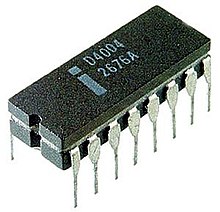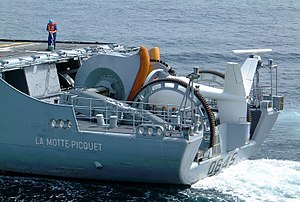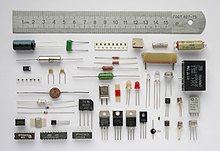Intel Corporation
 |
|
| Type | Public |
|---|---|
| Traded as | NASDAQ: INTC NYSE: INTC SEHK: 4335 Euronext: INCO Dow Jones Industrial Average Component NASDAQ-100 Component |
| Industry | Semiconductors |
| Founded | Mountain View, California (1968)[1] |
| Founder(s) | Gordon E. Moore Robert Noyce |
| Headquarters | Santa Clara, California, U.S.[2] |
| Area served | Worldwide |
| Key people | Jane E. Shaw (Chairman) Paul S. Otellini (President and CEO) |
| Products | Microprocessors Flash memory Motherboard Chipsets Network Interface Card Bluetooth Chipsets |
| Revenue | |
| Operating income | |
| Net income | |
| Total assets | |
| Total equity | |
| Employees | 82,500 (January 2010)[3] |
| Website | Intel.com |
Intel Corporation (NASDAQ: INTC) is an American global technology company and the world's largest semiconductor chip maker, based on revenue.[4] It is the inventor of the x86 series of microprocessors, the processors found in most personal computers. Intel was founded on July 18, 1968, as Integrated Electronics Corporation (though a common misconception is that "Intel" is from the word intelligence) and is based in Santa Clara, California, USA. Intel also makes motherboard chipsets, network interface controllers and integrated circuits, flash memory, graphic chips, embedded processors and other devices related to communications and computing. Founded by semiconductor pioneers Robert Noyce and Gordon Moore and widely associated with the executive leadership and vision of Andrew Grove, Intel combines advanced chip design capability with a leading-edge manufacturing capability. Though Intel was originally known primarily to engineers and technologists, its "Intel Inside" advertising campaign of the 1990s made it and its Pentium processor household names.
Intel was an early developer of SRAM and DRAM memory chips, and this represented the majority of its business until 1981. While Intel created the first commercial microprocessor chip in 1971, it was not until the success of the personal computer (PC) that this became its primary business. During the 1990s, Intel invested heavily in new microprocessor designs fostering the rapid growth of the computer industry. During this period Intel became the dominant supplier of microprocessors for PCs, and was known for aggressive and sometimes controversial tactics in defense of its market position, particularly against AMD, as well as a struggle with Microsoft for control over the direction of the PC industry.[5][6] The 2010 rankings of the world's 100 most powerful brands published by Millward Brown Optimor showed the company's brand value at number 48.[7]
Intel has also begun research in electrical transmission and generation.[8][9]
Contents
[hide]- 1 Corporate history
- 2 Product and market history
- 3 Corporate affairs
- 4 Competition
- 5 See also
- 6 References
- 7 External links
بقیه و متن کامل مقاله در ادامه مطالب...
Microprocessor

A microprocessor incorporates most or all of the functions of a computer's central processing unit (CPU) on a single integrated circuit (IC, or microchip).[1][2]
The first microprocessors emerged in the early 1970s and were used for electronic calculators, using binary-coded decimal (BCD) arithmetic on 4-bit words. Other embedded uses of 4-bit and 8-bit microprocessors, such as terminals, printers, various kinds of automation etc., followed soon after. Affordable 8-bit microprocessors with 16-bit addressing also led to the first general-purpose microcomputers from the mid-1970s on.
During the 1960s, computer processors were often constructed out of small and medium-scale ICs containing from tens to a few hundred transistors. The integration of a whole CPU onto a single chip greatly reduced the cost of processing power. From these humble beginnings, continued increases in microprocessor capacity have rendered other forms of computers almost completely obsolete (see history of computing hardware), with one or more microprocessors used in everything from the smallest embedded systems and handheld devices to the largest mainframes and supercomputers.
Since the early 1970s, the increase in capacity of microprocessors has followed Moore's law, which suggests that the number of transistors that can be fitted onto a chip doubles every two years. Although originally calculated as a doubling every year,[3] Moore later refined the period to two years.[4] It is often incorrectly quoted as a doubling of transistors every 18 months.
Contents
[hide]- 1 Firsts
- 2 8-bit designs
- 3 12-bit designs
- 4 16-bit designs
- 5 32-bit designs
- 6 64-bit designs in personal computers
- 7 Multicore designs
- 8 RISC
- 9 Special-purpose designs
- 10 Market statistics
- 11 See also
- 12 Notes and references
- 13 External links
بقیه و متن کامل در ادامه مطالب...
Sonar

Sonar (originally an acronym for SOund Navigation And Ranging) is a technique that uses sound propagation (usually underwater, as in Submarine navigation) to navigate, communicate with or detect other vessels. Two types of technology share the name "sonar": passive sonar is essentially listening for the sound made by vessels; active sonar is emitting pulses of sounds and listening for echoes. Sonar may be used as a means of acoustic location and of measurement of the echo characteristics of "targets" in the water. Acoustic location in air was used before the introduction of radar. Sonar may also be used in air for robot navigation, and SODAR (an upward looking in-air sonar) is used for atmospheric investigations. The term sonar is also used for the equipment used to generate and receive the sound. The acoustic frequencies used in sonar systems vary from very low (infrasonic) to extremely high (ultrasonic). The study of underwater sound is known as underwater acoustics or hydroacoustics.
Contents
[hide]- 1 History
- 2 Performance factors
- 3 Active sonar
- 4 Passive sonar
- 5 Warfare
- 6 Civilian applications
- 7 Scientific applications
- 8 See also
- 9 References
- 10 Bibliography
- 11 Further reading
- 12 External links
بقیه و متن کامل مقاله در ادامه مطالب...
Television
Television (TV) is a telecommunication medium for transmitting and receiving moving images that can be monochromatic (shades of grey) or multicolored. Images are usually accompanied by sound. "Television" may also refer specifically to a television set, television programming, television transmission.
The etymology of the word is derived from mixed Latin and Greek origin, meaning "far sight": Greek tele (τῆλε), far, and Latin visio, sight (from video, vis- to see, or to view in the first person.
Commercially available since the late 1920s, the television set has become commonplace in homes, businesses and institutions, particularly as a source of entertainment and news. Since the 1970s the availability of video cassettes, laserdiscs, DVDs and now Blu-ray Discs, have resulted in the television set frequently being used for viewing recorded as well as broadcast material. In recent years Internet television has seen the rise of television available via the Internet, e.g. iPlayer and Hulu.
Although other forms such as closed-circuit television (CCTV) are in use, the most common usage of the medium is for broadcast television, which was modeled on the existing radio broadcasting systems developed in the 1920s, and uses high-powered radio-frequency transmitters to broadcast the television signal to individual TV receivers.
Broadcast TV is typically disseminated via radio transmissions on designated channels in the 54–890 MHz frequency band.[1] Signals are now often transmitted with stereo and/or surround sound in many countries. Until the 2000s broadcast TV programs were generally transmitted as an analogue television signal, but in recent years public and commercial broadcasters have been progressively introducing digital television broadcasting technology.
A standard television set comprises multiple internal electronic circuits, including those for receiving and decoding broadcast signals. A visual display device which lacks a tuner is properly called a monitor, rather than a television. A television system may use different technical standards such as digital television (DTV) and high-definition television (HDTV). Television systems are also used for surveillance, industrial process control, and guiding of weapons, in places where direct observation is difficult or dangerous.
Amateur television (ham TV or ATV) is also used for experimentation, pleasure and public service events by amateur radio operators. Ham TV stations were on the air in many cities before commercial TV stations came on the air.[2]
Contents
[hide]- 1 History
- 2 Geographical usage
- 3 Content
- 4 Social aspects and effects on children
- 5 Environmental aspects
- 6 See also
- 7 References
- 8 Further reading
- 9 External links
بقیه و متن کامل مقاله در ادامه مطالب...
Telegraphy
| ) |
Telegraphy is the long-distance transmission of messages without physical transport of written messages. It is a compound term formed from the Greek words tele (τηλε) = far and graphein (γραφειν) = write. Radiotelegraphy or wireless telegraphy transmits messages using radio.
Contents
[hide]- 1 Terminology
- 2 Optical telegraph
- 3 Electrical telegraphs
- 4 Wireless telegraphy
- 5 Telegraphic improvements
- 6 Telex
- 7 Arrival of the Internet
- 8 E-mail displaces telegraphy
- 9 Worldwide status of telegram services
- 10 Social implications
- 11 Names of periodicals
- 12 See also
- 13 References
- 14 Further reading
- 15 External links
بقیه و متن کامل مقاله در ادامه مطالب...
Telephone
- "Phone" redirects here. For other uses, see Phone (disambiguation). This article is about the communications device. For other uses, see Telephone (disambiguation).
| Phone | |
|---|---|
 |
|
| An Olivetti rotary dial telephone, c.1940s |
The telephone (from the Greek: τῆλε, tēle, "far" and φωνή, phōnē, "voice"), often colloquially referred to as a phone, is a telecommunications device that transmits and receives sound, most commonly the human voice. Telephones are a point-to-point communication system whose most basic function is to allow two people separated by large distances to talk to each other. It is one of the most common appliances in the developed world, and has long been considered indispensable to businesses, households and governments. The word "telephone" has been adapted to many languages and is widely recognized around the world.
All telephones have a microphone to speak into, an earphone which reproduces the voice of the other person, a ringer which makes a sound to alert the owner when a call is coming in, and a keypad (or in older phones a telephone dial or no manual device) to enter the telephone number of the telephone being called. The microphone and earphone are usually built into a handset which is held up to the face to talk. The keypad may be part of the handset or of a base unit to which the handset would be connected. A landline telephone is connected by a pair of wires to the telephone network, while a mobile phone or cell phone is portable and communicates with the telephone network by radio. A cordless telephone has a portable handset which communicates by radio with a base station connected by wire to the telephone network, and can only be used within a limited range of the base station.
The microphone converts the sound waves to electrical signals, which are sent through the telephone network to the other phone, where they are converted back to sound waves by the earphone in the other phone's handset. Telephones are a duplex communications medium, meaning they allow the people on both ends to talk simultaneously. The telephone network, consisting of a worldwide net of telephone lines, fiberoptic cables, microwave transmission, cellular networks, communications satellites, and undersea telephone cables connected by switching centers, allows any telephone in the world to communicate with any other. Each telephone line has an identifying number called its telephone number. To initiate a telephone call, a conversation with another telephone, the user enters the other telephone's number into a numeric keypad on his/her phone. Graphic symbols used to designate telephone service or phone-related information in print, signage, and other media include ℡ (U+2121), ☎ (U+260E), ☏ (U+260F), and ✆ (U+2706).
Although originally designed for voice communication, the system has been adapted for data communication such as Telex, Fax and dial-up Internet communication.
Contents
[hide]- 1 History
- 2 Basic principles
- 3 Details of operation
- 4 Digital telephony
- 5 IP telephony
- 6 Usage
- 7 Telephone operating companies
- 8 Patents
- 9 See also
- 10 Notes
- 11 References
- 12 Further reading
- 13 External links
بقیه و متن کامل مقاله در ادامه مطالب...
Control system
A control system is a device or set of devices to manage, command, direct or regulate the behavior of other devices or systems.
There are two common classes of control systems, with many variations and combinations: logic or sequential controls, and feedback or linear controls. There is also fuzzy logic, which attempts to combine some of the design simplicity of logic with the utility of linear control. Some devices or systems are inherently not controllable.
Contents
[hide]- 1 Overview
- 2 Logic control
- 3 On–off control
- 4 Linear control
- 5 Fuzzy logic
- 6 Physical implementations
- 7 See also
- 8 References
- 9 External links
Digital electronics
Digital electronics represent signals by discrete bands of analog levels, rather than by a continuous range. All levels within a band represent the same signal state. Relatively small changes to the analog signal levels due to manufacturing tolerance, signal attenuation or parasitic noise do not leave the discrete envelope, and as a result are ignored by signal state sensing circuitry.
In most cases the number of these states is two, and they are represented by two voltage bands: one near a reference value (typically termed as "ground" or zero volts) and a value near the supply voltage, corresponding to the "false" ("0") and "true" ("1") values of the boolean domain respectively.
Digital techniques are useful because it is easier to get an electronic device to switch into one of a number of known states than to accurately reproduce a continuous range of values.
Digital electronic circuits are usually made from large assemblies of logic gates, simple electronic representations of Boolean logic functions.[1]
Contents
[hide]- 1 Advantages
- 2 Disadvantages
- 3 Analog issues in digital circuits
- 4 Construction
- 5 Non-electronic logic
- 6 Recent developments
- 7 See also
- 8 References
- 9 External links
Electronic engineering
Electronics engineering,[1] also referred to as electronic engineering,[2][3] is an engineering discipline where non-linear and active electrical components such as electron tubes, and semiconductor devices, especially transistors, diodes and integrated circuits, are utilized to design electronic circuits, devices and systems, typically also including passive electrical components and based on printed circuit boards. The term denotes a broad engineering field that covers important subfields such as analog electronics, digital electronics, consumer electronics, embedded systems and power electronics. Electronics engineering deals with implementation of applications, principles and algorithms developed within many related fields, for example solid-state physics, radio engineering, telecommunications, control systems, signal processing, systems engineering, computer engineering, instrumentation engineering, electric power control, robotics, and many others.[4][verification needed]
The Institute of Electrical and Electronics Engineers (IEEE) is one of the most important and influential organizations for electronics engineers.
Contents
[hide]- 1 Relationship to electrical engineering
- 2 History of electronic engineering
- 3 Electronics
- 4 Typical electronic engineering undergraduate syllabus
- 5 Education and training
- 6 Professional bodies
- 7 Subfields
- 8 See also
- 9 References
- 10 External links
Electronic circuit
An electronic circuit is composed of individual electronic components, such as resistors, transistors, capacitors, inductors and diodes, connected by conductive wires or traces through which electric current can flow. The combination of components and wires allows various simple and complex operations to be performed: signals can be amplified, computations can be performed, and data can be moved from one place to another.[1] Circuits can be constructed of discrete components connected by individual pieces of wire, but today it is much more common to create interconnections by photolithographic techniques on a laminated substrate (a printed circuit board or PCB) and solder the components to these interconnections to create a finished circuit. In an Integrated Circuit or IC, the components and interconnections are formed on the same substrate, typically a semiconductor such as silicon or (less commonly) gallium arsenide.[2]
Breadboards, perfboards or stripboards are common for testing new designs. They allow the designer to make quick changes to the circuit during development.
An electronic circuit can usually be categorized as an analog circuit, a digital circuit or a mixed-signal circuit (a combination of analog circuits and digital circuits).
Contents
[hide]بقیه و متن کامل مقاله در ادامه مطالب...












